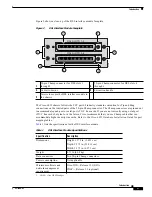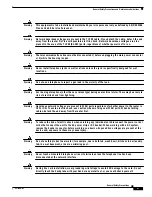
11
Removing and Installing the DSL Interface Module
OL-2186-01
Removing and Installing the DSL Interface Module
Follow these guidelines to prevent ESD damage:
•
Always use an ESD ankle or wrist strap and ensure that the wrist strap makes good skin contact.
•
Connect the equipment end of the strap to the ESD grounding jack. There are two ESD grounding
jacks that are located on the following Cisco 6015 chassis modules:
–
Fan module
–
DC PEM
•
When you install a component, use available ejector levers or captive installation screws to properly
seat the bus connectors in the backplane or midplane. These devices prevent accidental removal,
provide proper grounding for the system, and help ensure that bus connectors are properly seated.
•
When you remove a component, use available ejector levers or captive installation screws to release
the bus connectors from the backplane or midplane.
•
Handle the modules by the extraction handles only; avoid touching the printed circuit boards
or connectors.
•
Place a removed component board-side-up on an antistatic surface or in a static-shielding
container. If you plan to return the component to the factory, immediately place it in a
static-shielding container.
•
Avoid contact between the printed circuit boards and clothing. The wrist strap protects components
from ESD voltages on the body only; ESD voltages on clothing can still cause damage.
Caution
Periodically check the resistance value of the antistatic strap. Ensure that the measurement is between 1
and 10 megohms.
Removing and Installing the DSL Interface Module
The following sections describe how to remove or install a DSL interface module.
Caution
Proper ESD protection is required whenever you handle Cisco equipment. Installation and
maintenance personnel should be properly grounded by means of grounding straps to eliminate the
risk of ESD damage to the equipment. Equipment is subject to ESD damage whenever it is removed
from the chassis.


















